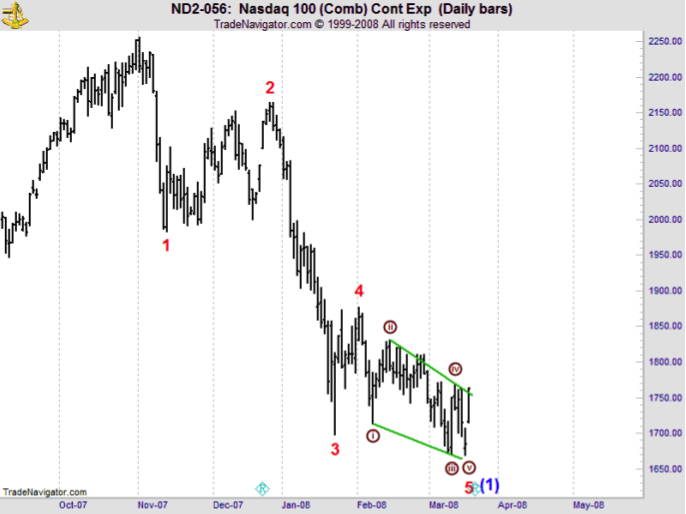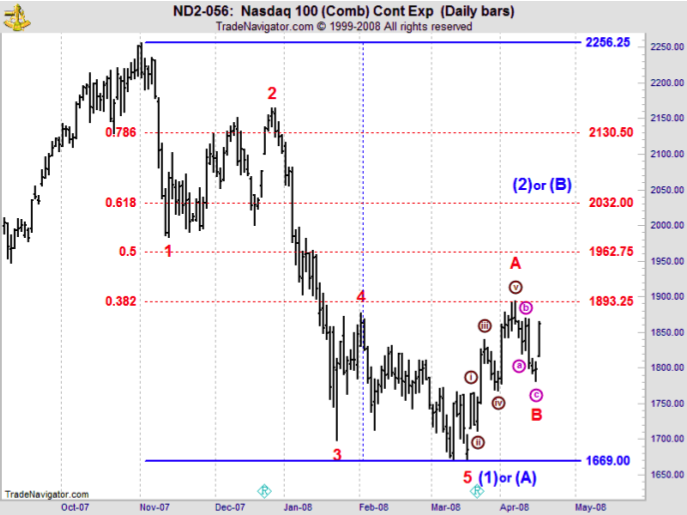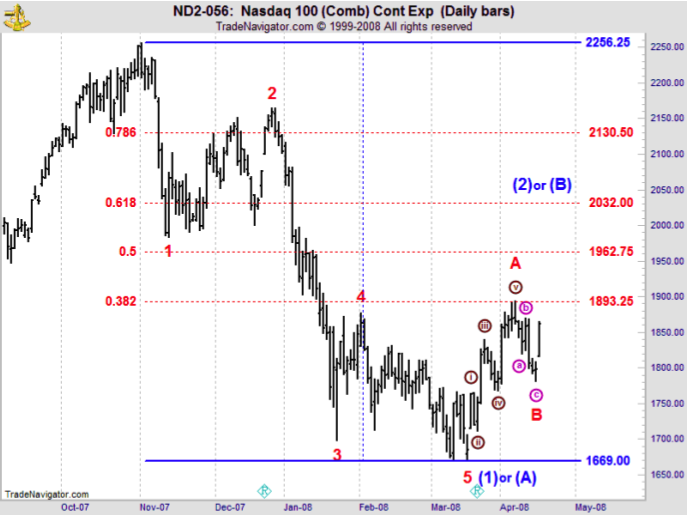EWP Option Strategies – Part 4
EWP Option Strategies – Part 4
Alright, Evil Rat Academy is officially in session – and it’s again a good time as there is not much to do but to watch Soylent Blue inflict its monetary and psychological damage on the bears. But moping and complaining is not something we advocate here at the evil lair. So, let’s make this again this a productive day before we head into the weekend.

Since it’s Friday and I have no compunction about exploiting your prolific disposition towards cheap thrills I hope that the newly introduced (and now obligatory) female school uniform at Evil Lair Academy may help rise your interest a little – well, or something else…
Now it’s time for the fourth part in our ongoing EWI sponsored series on option strategies. The following post is excerpted from the Elliott Wave International (EWI) eBook, “How to Use the Elliott Wave Principle to Improve Your Options Trading Strategies — Vertical Spreads.” EWI has agreed to make the full eBook available for free to all Evil Speculator readers until the conclusion of this series. So go ahead and download it here if you want to study ahead – however I would appreciate it if we kept all discussions limited to the current chapter.
Last time you were introduced to two three legged beasts among option spread strategies – the bear put ladder and bull call ladder. If you missed that chapter then I strongly recommend you go back and study it before continuing here, otherwise you will most likely not be able to follow the following example. You can also pull up all prior installments of the the entire series via this link.
So, let’s now look at a real world example of a bull call ladder on the NDX (Nasdaq 100) futures:
Fig. 18
Figure 18 is an Elliott wave-labeled chart of the NASDAQ 100 from October 2007 to March 2008. As you can see, we have completed Minor waves 1, 2, 3, 4, and 5 (red) of Intermediate wave (1) (blue). Within Minor wave 5, we see a familiar formation: a fifth-wave ending diagonal (the same pattern we saw in Figure 4 of the euro/U.S. dollar). As we already learned, ending diagonals are one of three patterns that precede a dramatic reversal. The other significant development is a gap up from March 17th to March 18th, after the culmina- tion of the ending diagonal. If we were doing an outright long futures trade, this area (in and around March 17) would represent the most promising entry point. Keep in mind, however, that during this part of the lesson, we are not going to simulate all trading possibilities. We’ll wait until we reach the proper juncture to do a bull call ladder or bear put ladder.
Based on what we know about ending diagonals, the next likely move will be up and sharp. The option strategy of choice is a bull call spread; this time, in the opposite direction of what we did on the euro. And the outside target is where the diagonal began, which is at 1,876.75, the end of Minor wave 4. Let’s see what happens.
Fig. 19
Figure 19 shows that we did, in fact, make a swift reversal back to (and even beyond) where the diagonal began. The move unfolded as Minute waves 6 through 0 of Minor wave A (red) of Intermediate wave (2) (blue). Had we done a bull call spread, the trade would have been a success. Assume that we got the move, did the bull call spread and we got out. Now what?
Unless our wave count is totally wrong, Intermediate wave (2) is now under way. We have a countertrend move of small degree. We know that wave 2 always retraces less than 100% of wave 1, which would help to deal with uncapped risk situations. Ulti- mately, the setup is ideal for a bull call ladder. We want to earn some premium on the uncovered short call, but we also want a good amount of distance between our entry point and the second breakeven. Hopefully, in this case, our upper limit or breakeven will be in the area where wave (2) can never go. If we enter the bull call ladder too low relative to the expected move, our second breakeven will be within range of wave (2), and we could lose money. If we sold an out-of- the-money call much further up to avoid losing money, we wouldn’t get much premium for it at all. We have to find a compromise between these two objectives. So, we have to do the bull call ladder at least in the middle of the anticipated upward price move. The anticipation is, of course, for a Minor wave B down followed by Minor wave C up.
Fig. 20
Figure 20 shows that Minor wave A within wave (2) has retraced .382 of Intermediate wave (1) at 1,894 (the exact .382 level was 1,893.25). This is important, because second waves do NOT make shallow retracements. They generally carve out much deeper ground, such as .500, .618, .786 and so on, as high as possible while staying below the start of wave one. So we’re going to plan for the C wave within wave (2), and we’re going to look for a much deeper retracement. I’ve added a Fibonacci table to the chart to identify the potential upside targets for Minor wave C. So, let’s move ahead.
Fig. 21
I’ve labeled the ensuing price action Minor wave B. It made about a 50% retracement of wave A. We’ve also gapped up, which could be the start of wave C. But, we need to be cer- tain. There are a couple of guidelines we can use here to lead us forward. First, Minor waves A and B look to be forming a zigzag; this is a simple three-wave pattern labeled a-b-c in which the subdivisions are 5-3-5. And, in a zigzag, the most common relation- ship for wave C is that wave C equals wave A.
Another guideline is that wave C may also equal 1.618 times wave A. In this case, Minor wave C equals Minor wave A at 2,006.50. The .618 is 2,032 — very close. Minor wave C equals 1.618 times wave A at 2,145.50. So, we will eliminate the higher Fibonacci retracement level of .786 (at 2,130.50) and 1.618 times the length of wave A (at 2,145) and turn our eyes down to the 2,000-2,032 area for a likely target, because we have a Fibonacci cluster there.
Fig. 22
Based on our analysis, we’re going to do a bull call ladder on April 16, 2008. Remember that I am using “closing” option prices specifically. On April 16, the futures price closed at 1,862.50. So, we’re going to buy a slightly in-the-money June 1850 call at 84 points. We’re going to sell an out-of-the-money June 2010 call at 18.50 points — right around the area where Minor wave C equals A, and close to the .618 retracement level. This is where we expect wave (2) to end. The June contract expires on June 20, 2008.
As you can see in Figure 22, there is also a short out-of-the-money June 2050 call at 11 points. The purpose of this second short call is to produce more income with manageable risk. The result is a second breakeven that is beyond the .786 retracement of 2,130.50. (.786 is about the maximum retracement for second waves, but it is possible for second waves to experience a 99% retracement.) So, the goal is to get a decent amount of premium that reduces the net debit, and create a high second breakeven level that provides a cushion against that uncovered short call, in case prices go past the 2,050 area where we’re exposed.
I have a net debit of 54.50 points. My maximum risk is still uncapped: Maximum risk on a down move is 54.50 points, on an up move it’s uncapped, and maximum reward is 105.50 points. The lower breakeven is 1,904.50. The upper breakeven is 2,155.50, which is based on the gain the strategy would make — between the buy call and first sell call — as prices move up, less the net debit. That breakeven is also beyond the .786 retracement of 2,130.50, an area where wave (2) is unlikely to go. Ideally, if it’s a fast-moving market and prices abruptly skyrocket or plunge, I would call my broker to exit at 2,010 or unwind at 1,780. But, if he can’t get me out, I still know that after 2,010, there are 145 more points of upward movement before the market reaches 2,155 — and that’s just breakeven. A move below 1,781.50, the low of Minor wave B, would negate the wave count, and I would look to close out the position.
Footnote: I selected these particular strikes based on the Elliott wave analysis and the market premiums that were available. In the end, after doing several calculations, they were the best I could do for this trade. Implied volatility is 24.6%.
Fig. 23
In Figure 23, you can see that we did indeed move up in what looks like Minor wave C. And, on May 13, we hit our objective of 2,010. So, what do we do now? That’s easy: We get out. There is no other reason to stay in this trade anymore. It’s a high-risk trade, and when you read the options litera- ture, you’ll probably see a number of people who aren’t in favor of this type of strategy. Assuming we can get out and it’s not a fast-moving market, we close on May 13. These are the prices: I sold the June 1850 calls at 168.50 points and bought back the other June calls — one strike at 50.75 points and the other at 31.25 points. We had a net credit of 86.50. The implied volatility was 20.4%. And we had a net profit of 32.00 points, producing a return on investment of 59 percent. As always, the question remains: Did we capital- ize on the opportunity at hand? The next chart has the answer.
Fig. 24
Minor wave C of Intermediate wave (2) finally peaked at 2,062.75, very near the previously cited .618 level of 2,032 and then prices turned down. So, as others in the trading world might say to us, “You got lucky on that one.” However, we know that along with a little luck, we also had some good Elliott wave analysis to help us.




















